Cube-Mounted Pellicle Beamsplitters

- No Ghosting or Beam Displacement
- No Chromatic Aberration with Uncollimated Beams
- SM1 and 30 mm Cage System Compatible
CM1-CC
CM1-BP145B1
CM1-BP145B3
Michelson Interferometer
with Pellicle Beamsplitter
Application Idea

Please Wait
| General Specifications | |
|---|---|
| Ports | 4, all SM1 Threaded (1.035"-40) |
| Membrane Material | Nitrocellulose |
| Housing Material | Engraved Black Anodized Aluminum |
| Membrane Thickness | 2 µm, 5 µm for 300-400 nm Version |
| Temperature Range | -40 to 70 °C |
| Index of Refraction | 1.5 at 550 nm |
| Surface Quality | 40-20 Scratch-Dig |
| Transmitted Wavefront Error | 0.5λ (Typical) |
| Reflected Wavefront Error | 1λ (Typical) |
| Item # (Click to View) | Wavelength | Splitting Ratio (R:T) |
|---|---|---|
| CM1-BP108 | Uncoated, 400 nm - 2.4 µm |
8:92 |
| CM1-BP145B5 | 300 - 400 nm | 45:55 |
| CM1-BP145B1 | 400 - 700 nm | 45:55 |
| CM1-BP133 | 635 nm | 33:67 |
| CM1-BP150 | 635 nm | 50:50 |
| CM1-BP145B2 | 700 - 900 nm | 45:55 |
| CM1-BP145B3 | 1 - 2 µm | 45:55 |
| CM1-BP145B4 | 3 - 5 µm | 45:55 |
Features
- Eliminates Ghosting
- No Chromatic Aberration with Focused Beams
- Minimal Change in Optical Path Length
- SM1-Threaded Entrance and Exit Ports
- 30 mm Cage System Compatible
Thorlabs' Ø1" mounted pellicle beamsplitters are ideal for use in applications where chromatic dispersion must be minimized (i.e. cases where focused beams are necessary). These beamsplitters virtually eliminate ghosting since the second surface reflection is superimposed on the first one. However, they are extremely fragile due to the nitrocellulose membrane being microns thick, which exhibits less than 1/2 wave of variation at 635 nm across its 25 mm diameter. To provide maximum protection from damage, these beamsplitters are housed inside a 30 mm cage-system-compatible cube. The cubes are post-mountable and have SM1-threaded access ports, making them compatible with our entire line of Ø1" lens tubes and accessories. The cubes are M6 x 0.5 threaded, but include 8-32 and M4 mounting adapters. These Beamsplitter cubes can also be connected to other cage cubes with cage rods and our ERSCB adapters.
Please Note: Pellicle beamsplitters exhibit sinusoidal oscillations in the splitting ratio as a function of wavelength, due to thin film interference effects. See the Thin Film Tutorial tab for more details. These sinusoidal oscillations can be clearly seen in the plots below.
The engraving on the top of the mounts indicates the direction of incident light. This direction is consistent with the light being incident upon the coated surface of the beamsplitter first.
Thorlabs offers three types of mounted beamsplitters: Non-Polarizing Beamsplitting Cubes, Polarizing Beamsplitting Cubes, and the Pellicle Beamsplitters presented below. A large variety of unmounted beamsplitters are also available. For a direct comparison of the performance of our non-polarizing beamsplitting cube, plate, and pellicle at 633 nm, see the Lab Facts tab.
For a complete selection of our cube-mounted optics please see the Mounted Optics Guide tab.
Handling Precautions
Our pellicle beamsplitters are manufactured from an extremely thin and fragile membrane. Please do not touch the membrane under any circumstances. Compressed or canned air can be used to clean these beamsplitters, but please exercise caution as the force of the air may be large enough to damage the membrane. Aim the stream of air such that it makes a small angle with the surface, and hold the can sufficiently far away to avoid damaging the membrane. If the pellicle becomes damaged, please contact tech support for information about replacement of the beamsplitter; in these cases, we only charge for the cost of the pellicle.
Thorlabs Lab Fact: Beamsplitter Package Matters
We present laboratory measurements of the polarization angle, split ratio, and total throughput power of a beam transmitted through Thorlabs plate, cube, and pellicle beamsplitters. While all non-polarizing beamsplitters function similarly, the exact performance is different for different types of beamsplitter. Each type of beamsplitter contains its own advantages and disadvantages compared to other types of beamsplitters. Appropriate choice of beamsplitter is essential to sensitive experimental systems. We present a complete analysis and comparison of optical parameters for three common types of non-polarizing beamsplitters.
For our experiment we used the former generation HRS015 stabilized HeNe laser (replaced by the HRS015B) as the light source for our investigation. A linear polarizer is used to set the laser beam's polarization axis to 45° in order to provide equal S- and P-polarized light incident on the beamsplitter. The beamsplitter under investigation was then placed in the beampath, and its split beams directed to appropriate detectors. The total power though the optic, polarization states, split ratios, and angle of incidence effects were investigated under this configuration.
The plots below summarize the measured results for all three types of beamsplitters. From these graphs the performance of each optic can be easily compared to one another. The bottom left plot summarizes the results for the total power throughput for each optic. The total power throughput is measured as the fraction of input power. While the plate and pellicle beamsplitters perform rather similarly, the cube shows signs of absorption inside the optic. Additionally, this plot shows the relative insensitivity of throughput power to angle of incidence. The bottom middle graph summarizes the results for the output polarization angle for each optic. The cube shows the most similar polarization angles between the reflected and transmitted beams, with the plate producing the largest difference in polarization between beams. The bottom right plot summarizes the results for the split ratio, as a fraction of input power, for the beamsplitters. Here it can be shown that the plate beamsplitter demonstrates the most ideal for 50/50 power splitting. For details on the experimental setup employed and the results summarized here, please click here.
Thorlabs' portfolio contains many different kinds of beamsplitters, which can split beams by intensity or by polarization. We offer plate and cube beamsplitters, though other form factors exist, including pellicle and birefringent crystal. Many of our beamsplitters come in premounted or unmounted variants. Below is a complete listing of our beamsplitter offerings. To explore the available types, wavelength ranges, splitting/extinction ratios, transmission, and available sizes for each beamsplitter category, click More [+] in the appropriate row below.
Non-Polarizing Beamsplitters
| Plate Beamsplitters |
|---|
| Cube Beamsplitters |
|---|
| Pellicle Beamsplitters |
|---|
Polarizing Beamsplitters
| Plate Beamsplitters |
|---|
| Cube Beamsplitters |
|---|
| Birefringent Crystal Beamsplitters |
|---|
Other Beamsplitters
| Other Beamsplitters |
|---|
30 mm Cage-Cube-Mounted Optics Selection Guide
The table below provides links to all of our 30 mm Cage-Cube-Mounted optics. For our selection of 16 mm Cage-Cube-Mounted Optics, please see our 16 mm Cage Systems guide.
30 mm Cage Cube Empty Optic Mounts Selection Guide
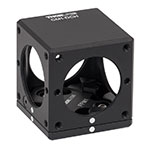 |
 |
| Rectangular Dichroic Mirrors and Filters | Empty Compact 30 mm Cage Cube |
Thin-Film Interference Effect

The plots below, which show transmission as a function of wavelength, depict a sinusoidal fluctuation that is caused by interference effects. These effects will occur for all pellicle beamsplitters and are sometimes averaged out when data is displayed.
The graph to the right depicts the actual measured percent reflectance of an 8:92 beam sampler without averaging the sinusoidal oscillations that result from thin film interference. The frequency and amplitude of the pattern depends on four factors: the thickness of the film, the thickness of any coating present, the angle of incidence of the incoming light, and the polarization of the incoming light.
Q: What is a thin film?
A layer of material is referred to as a thin film if the thickness of the layer is on the order of the wavelength of incident radiation in the film medium. The relationship between the wavelength of light in air and that in the film is given by

For the pellicle beamsplitters featured here, the information under the Specs tab states that nfilm = 1.5 at 550 nm. Therefore, for this incident wavelength, the wavelength in the pellicle membrane itself is

| Posted Comments: | |
eirini.tagkoudi
(posted 2018-03-19 16:07:08.15) I would like to kindly ask you what is the damage threshold for the specific pellicle beam-splitter since i am using high peak power lasers and I am not sure if this optical component is the most suitable. Thank you in advance. YLohia
(posted 2018-03-30 01:02:41.0) Hello, thank you for contacting Thorlabs. While the laser induce damage threshold is still an undetermined spec for CM1-BP145B3, we recommend limiting the incident CW power density to 2 W/cm^2 for the coated pellicles in general as a guideline. Unfortunately, we currently do not have a pulsed LIDT spec. kbeloshenko
(posted 2018-01-29 12:25:59.283) Dear sir!
Please tell me what components I need to use for prepare the Michelson Interferometer with Pellice Beamsplitter. I would like to use 400-1000 nm optical range.
Very best regards
Konstantin Beloshenko tfrisch
(posted 2018-02-06 11:08:43.0) Hello, thank you for contacting Thorlabs. Strictly speaking, a Michelson interferometer requires a source, a beamsplitter, two mirrors, and a viewing screen or detector. Then, optomechanical components are required to align those. We have a Michelson Interferometer Educational Kit (see link below). Even if that is more than you are looking for, we list the kit components so you can pick the pieces you want for your application. That would be a good place to start, but I will reach out to you directly to discuss your needs.
https://www.thorlabs.com/newgrouppage9.cfm?objectgroup_id=10107&tabname=Kit%20Components schneider
(posted 2017-09-28 12:41:33.773) Just a hint: I use CM1-BP108 pellicle beamsplitters in an optical trap to split the laser to a segmented position detector (PDQ80A). The problem is, that when I use them in reflection, the pellicle acts as a microphone membrane picking up the noise in the lab (pumps etc.), which results in several peaks in my frequency spectra due to the membrane vibrations and, thus, a shift of the laser in the detector. In transmission the laser is almost unaffected by the pellicle. tfrisch
(posted 2017-10-02 07:02:44.0) Hello, thank you for contacting Thorlabs. Because the transmitted wavefront error is a refractive effect and the path length is very short, I'd expect the transmitted path to be affected far less by vibrations as you note. I will reach out to you directly to discuss your application. roland.bege
(posted 2015-06-24 11:03:00.127) I have a beam splitter CM1-BP108 uncoated. My question is, what is the damage threshold if I have a collimated beam with a diameter of 3 mm. I would like to us it for powers up to 5 W at around 1100 nm. Thanks besembeson
(posted 2015-08-18 12:24:13.0) Response from Bweh at Thorlabs USA: The uncoated pellicle will withstand that power level, cw or pulsed. Note that localized heating of the film may change the thickness slightly causing a change in the R/T. Changing the incidence angle will help tune the R/T ratio if critical for application. steven.woodruff
(posted 2013-06-24 12:20:28.693) This looked to be what I needed, then looked at the cad drawing. The beamsplitter is circular and needs to be elliptical so that there is full beam transmission through the BS. Look at reflector telescopes to see the usefulness of an elliptical mirror, it has a circular shape when viewed at 45 degrees.
Steve tcohen
(posted 2013-07-11 16:25:00.0) Response from Tim at Thorlabs: Thank you for your feedback. We do carry elliptical mirrors but currently all of our pellicles are circular. I am checking into our ability to provide this and I will contact you to keep you updated. jlow
(posted 2013-01-04 09:44:40.02) Response from Jeremy at Thorlabs: If the pellicle inside is damaged, we can take back the cube-mounted pellicle for repair. In such a case, we will only charge the price of the replacement pellicle. farrell
(posted 2012-12-21 17:28:21.01) I am worried about the lifetime of cube mounted Pellicle beam splitter. I agree they are better protected, however they are also 4 times more expensive than the unmounted type. Is it possible to purchase an unmounted type an insert it into the cube as a replacement if/when needed? tcohen
(posted 2012-07-05 14:03:00.0) Response from Tim at Thorlabs: We currently do not have empirical data for the CM1-BP145B1 LIDT. However, we recommend not exceeding 2W/cm^2 for these beamsplitters. Please use this as a reference, but note that other factors, as described in our LIDT tutorial at http://www.thorlabs.de/tutorials.cfm?tabID=27503, will vary this number. doron.azoury
(posted 2012-07-05 15:21:35.0) Can you provide the damage threshold of CM1-BP145B1 (pellical beamsplitter), for cw laser? Thanks. tcohen
(posted 2012-05-01 19:07:00.0) Response from Tim at Thorlabs: Thank you for your feedback. You are correct that these are averaged graphs and that individual parts will have oscillations from interference. We note this in the footnote as you mentioned and also provide a “Tutorial” tab on the Pellicle Beamsplitters page describing this interference effect. If you would like to see an example of this curve for a specific part number, please contact us at techsupport@thorlabs.com so we may provide you with this data. user
(posted 2012-05-01 11:32:42.0) The thin film interference referred to in the footnote to the graphs can be excessive. The graphs are from averaged data that hides these oscillations. Ask for a representative graph prior to purchase. |


Click to Enlarge
Two CM1-CC Connectors used to Connect Multiple 1.5" Wide Cage Cubes
- Connect Two 1.5" Wide Cage Cubes Side by Side
- Compatible with CM1 and CCM1 Series Cage Cubes
The CM1-CC cube connector allows two or more cubes to be connected as shown in the image to the right. Many of our cage cubes are compatible with this connector, including empty cubes, empty dichroic cubes, mounted beamsplitters, mounted penta prisms, and mounted turning mirrors.
Two cage cube-mounted turning mirrors cannot be connected using the CM1-CC due to a lack of Ø6 mm cage rod holes on two sides of the cube.
Alignment Pins
Please note that because dowel alignment pins are used, the connector requires drilled holes on the cube face between the SM1-threaded (1.035"-40) ports. If you have an older cube and would like it updated to have alignment holes for free, please contact Technical Support. Alternatively, the alignment pins are press-fit inside their mounting holes, and can be pressed out for use with cubes that do not have these alignment holes.
 Products Home
Products Home















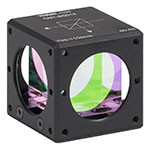
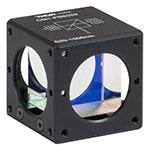
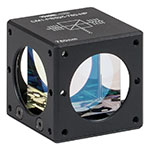
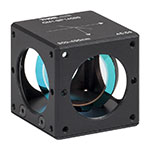


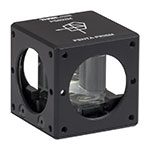

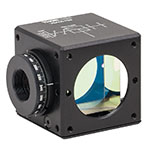
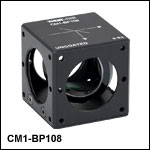
 Zoom
Zoom

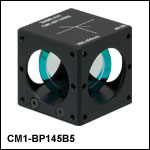


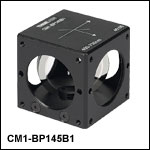


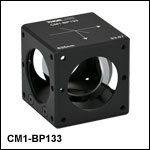





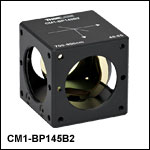


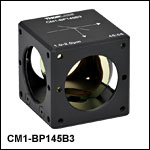


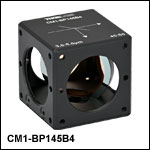



 Cube-Mounted Pellicle Beamsplitters
Cube-Mounted Pellicle Beamsplitters